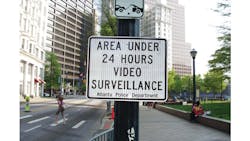Initial reports suggesting the usage of video surveillance technologies by police authorities to secure public areas and fight crime appeared as early as 1965. One of the earliest references mentions Olean, New York as the first city in the United States to deploy video cameras for surveillance purposes along its main business street. That 1968 installation was soon followed by the city of New York placing cameras in its municipal building in 1969. Times Square had its very first surveillance cameras installed in 1973.
More than 40 years later, the original initiative to use video surveillance technologies to help secure cities remains. In addition to being a staple solution in security, video has recently become a substantial facet in a much wider concept, considered by many as the technological future of cities– the Smart City.
The Correlation Between Safe and Smart Cities
The convergence between the Safe City and the Smart City concepts can be looked at in two different ways. From a top down, holistic approach, the term Smart City refers to the city entity as a business hub, having its residents and business owners considered as customers. As such, one of the main goals of a Smart City is ‘to continuously improve the quality of living’ for its customers. From an economic standpoint, this would increase the value of the city, attracting residents and business owners with greater economic capabilities. This would ultimately increase the income from taxes.
Security and safety are two crucial factors and direct influencers on the quality of living within the city and its surroundings. Making a city safer and more secure directly contributes to its ‘smartness’ and ability to have its agencies efficiently execute their responsibilities to secure the metropolitan area and enhance public safety.
From a bottom up observation, the fundamental elements of an IP-based video surveillance system include security cameras that are controlled and managed by software-based systems, usually referred as Video Management Software or Video Management Systems (VMS). While security cameras are in fact visual sensors, modern VMS platforms today segregate other types of sensors, including audio, motion detection and access control to name a few. These sensors provide a higher level of synergy and global situational awareness to events that are taking place across the monitored areas.
From a technological standpoint, Smart Cities obtain subsystems for specific purposes and then segregate them to combined systems leveraging existing infrastructure to generate additional value. Specifically, this is typically achieved through utilization of an infrastructure, which enables correlation and communication between different types of sensors over a shared, citywide network for the purpose of achieving a better understanding and determination of situations. The immediate result is optimized decision-making and automation, which are in many cases the main objectives for deploying enterprise grade video surveillance solutions across modern metropolitan areas today.
Smart Solutions for Safer Cities
Devices surrounding us are getting smarter each day. Just as innovation is occurring with mobile phones, television and cars, important enhancements have been made in surveillance cameras. Smart imaging is a great example. The birth of features such as Wide Dynamic Range (WDR), P-iris, and image stabilization, accompanied with high megapixel count, are just some of the inventions that have been made in video imaging. Today, common camera resolutions range anywhere from 1080P full HD, which is considered as the minimal standard, up to 4K Ultra HD resolution that aims to become the new evidentiary class standard for wide area surveillance. These features allow cameras to produce higher quality images with greater level of details, while also overcoming various environmental challenges such as poor lighting or complex scenes that often occur in a city environment.
Furthermore, video intelligence is another form of evolution. More manufacturers are offering cameras with built-in algorithms that are capable of detecting and concluding various scenarios independently and without a need for a back-end server to drive conclusions. Existing offerings today include cameras that are capable of reading a vehicle’s license plate, detecting crowds or simply identifying a vehicle within traffic.
While smarter cameras provide greater capabilities beyond generation and transmission of video, the key contributing factor to the Smart City concept is their ability to communicate with the central management system over the network, delivering their video analytics output, either alarms or metadata, alongside with the associated video stream. By doing that, these cameras are serving as multipurpose sensors, providing visual as well as scene related data to a central hub, where it can be further engaged with other types of information arriving from other sensors.
An example scenario is a shooting incident taking place in a street. While any traditional system could be used to capture evidence for forensic and evidence collection, given that the area of interest was originally covered by stationary cameras and relevant footage has been taken, smart systems deployed within Smart City domains can help achieve two important goals. The first objective is to ensure that relevant footage will be taken immediately after the shot was fired, and the second is to allow a quick and efficient response in real-time to the incident. This can be achieved by coupling gunshot detection sensors, motorized Pan-Tilt-Zoom (PTZ) cameras and a centralized VMS.
Gunshot detection technology utilizes audio sensors that are not only capable of detecting a sound of a gunshot, but that can also determine the exact location of its origin using GIS coordinates. When Gunshot Detection is integrated with a centralized VMS and associated with motorized PTZ cameras that are deployed across neighboring areas, security staff and first responders can be notified immediately. Once a gunshot fires, an alarm will be generated in the VMS (located in the central control room), the shot will be classified as gunshot alarm, and the exact location where the gun was fired will be provided by the GIS coordinates.
The alarm can be displayed on top of a digital map, providing a better understanding of that position and potential routes. With that, law enforcement forces can be quickly and efficiently directed to the area of incident. At the same time, neighboring PTZ cameras are automatically directed to the relevant location, taking real time footage while zooming in, providing live evidence from the scene, and potentially capturing the suspect(s) on video during their escape.
Additional components may also come into play. For instance, smartphone applications available today can stream live footage to the VMS residing in the central command and control room. Any law enforcement agent or other early responder that is equipped with such software and is present onsite can use his phone to deliver real-time video directly from the scene while additional forces are heading to that location. This allows staff to see an additional angle and closer look at the scene beyond the reach of the stationary surveillance cameras.
Similar capabilities are supported by some wearable camera platforms, allowing a mobile means of capturing footage during the time of the event. Lastly, information received by license plate recognition (LPR) cameras, can be used to collect vehicle data before, during and shortly after the incident. Together, data collected by LPR in addition to other neighboring cameras, maximizes the details available about suspect vehicles.
Accessibility is a Necessity
Although generating and aggregating data is an important part of Smart City video surveillance, data accessibility is another key feature that should not be overlooked. No matter how efficient the data is, it is the ability to access it that determines its effectiveness during the time of an incident. While the direct responsibility to secure the streets, roads and most public areas is under the municipality and its local law enforcement agency, other facilities such as schools, campuses, hospitals and museums are self-managed by its entities. In fact, the owner of the video surveillance system will in most cases be the facility itself. At the same time, to be able to fulfill its goal of being truly smart, the city entity and specifically the organizations that carry the responsibility to secure and protect it, should be able to access information during emergencies taking place at a self-managed entity. This should be possible regardless of the fact that it may be a different system, hardware or simply software version that are used at the local entity from the one deployed at the city’s central control room.
Few enterprise grade systems offered today provide unified infrastructure and multisite hierarchy so that, for example, an incident at a local school could generate an alarm at a central command and control center monitored by the local law enforcement agency. Other requirements point at using web based interfaces, optionally on various mobile devices, to easily access remote systems at all times. This increases the robustness of the system, as it is not limiting the ability to access data to users that are physically sitting in a control room.
Evolving Cyber Threat
Back in the 1960s, video surveillance systems were basically closed circuit television systems (CCTV) utilizing analog cameras to transmit video via coax cables to monitor and also using analog tape based storage in a closed loop. Today video surveillance has almost completely transitioned from analog to IP, where visual and other forms of data are fully digitalized, managed and transmitted over IP network by computerized software based systems.
Segregation of systems and need for high availability data access have driven the merge of video systems into enterprise networks. The integration has allowed access to video from any location and promoted the usage of multiple entry points such as web clients, smartphones and cloud. This is the case of most enterprise grade systems and definitely when it comes to citywide deployments striving to reach the goals of the Smart City concept. Similar trends are the case of other non-video surveillance segregations that co-exist within the Smart City infrastructure. While the benefits are huge and technology adoption continues, each and any communication point within the Smart City domain is becoming exposed to various cyber threats that IT departments have been facing for years.
Specifically, video surveillance is greatly increasing the exposure levels due to a number of reasons – the first being an optional network that, on one hand, is not fully managed and controlled by the IT department. On the other hand, the network can be used as a backdoor to other networks within the domain with multiple entry points including each and any camera across the system. Other points of vulnerabilities are the various web-based incoming and outgoing traffic such as wireless networking. Secondly, the video itself is a valuable asset to some attackers. Hackers are usually either interested in a video’s content or in the benefit of having the video tampered with in order to damage the security layers designed to prevent crime.
Proper and effective handling of potential cyber breaches in a multi-layered and multi-disciplined system such as the ones being used by Smart Cities require a bottom up approach. In other words, each sub system needs to be independently protected at any point of vulnerability. This is also the case of video surveillance systems that require built-in cyber protection mechanisms to prevent them from becoming a weak link in the cyber chain allowing backdoors and Trojan horses. Few leading vendors of video surveillance solutions have acknowledged their role in the war against cyber. Only a handful of video manufacturers are offering technology features that combine existing components, as well as a firm roadmap to seal, authenticate, encrypt and harden their hardware, while simultaneously providing new development standards and certifications designed to address the growing concerns of cybercrime threats.
About the Author:
Ron Grinfeld currently serves as Director of Global Vertical Marketing for DVTEL. He has more than 15 years of experience in video technologies for the consumer, physical security and IT industries. He has held senior-level roles in R&D, Marketing, Product, Business Development, Support and Professional Services. Prior to his current position in DVTEL, he served as the company’s Director of R&D for edge devices, responsible for the development, execution and maintenance of DVTEL’s camera and encoder lines. Prior to joining DVTEL, he was Director of Professional Services and head of global support at Agent Vi.
Secured Cities Note:
DVTEL will be monitoring a session at the upcoming Secured Cities conference in Houston on November 10-12, entitled; Proactive Technology to Secured Hospital Campuses. This session is scheduled for Thursday, November 12 at 9:00 am at the Crowne Plaza Reliant Center Hotel. For more information on this session and others, please click onto: http://securedcities.com/conference.php


